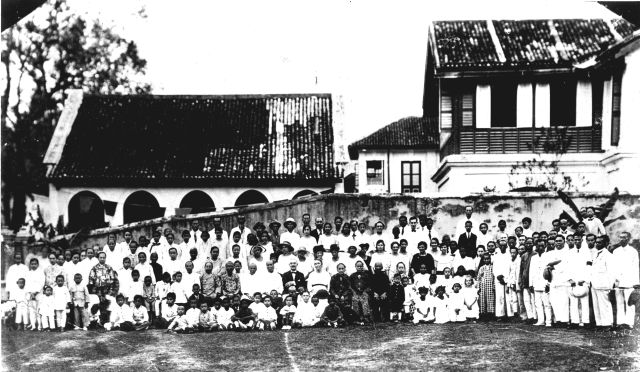(Celebrated on May 28, 2005 in Penang)
Simple Worship, Resolute Faith
[The following article was published by the New Straits Times on May 28, 2005]
Simple Worship, Resolute Faith
By Chan Siang Yen
In commemorating the 150th anniversary of the Christian brethren church movement today, CHAN SIANG YEN writes of its beginnings and the missionary work of the pioneers.
It is difficult to imagine that the abandoned building next to the Lim Lean Teng mansion could have been of any significance in the history of Penang’s “Christian brethren” churches. But the pioneer missionaries who occupied 35 Lebuh Farquhar some 150 years ago spearheaded a movement that later reached into other parts of the peninsula and even Singapore.
These pioneers were either not famous or notorious enough to have made an impact in the annals of history. Nevertheless, they left their mark, contributing to the growth of the brethren church and society. The Christian brethren assembly from all over the nation will today commemorate the 150th anniversary of their assembly testimony in Penang at Kompleks Masyarakat Penyayang. The gathering will be followed by a dinner at the Sri Tanjung Club in the vicinity.
Ung Kim Cheng, advisor to the organising committee from Burma Road Gospel Hall (BRGH), hopes that through this event, the future leaders of the assemblies will emulate the spirit of these early pioneers in their vision and mission. “If our history is forgotten, there would be no role models to follow and much of what they sacrificed would be lost.”
The movement, commonly known as the “brethren movement”, became popular in the early 1820s in Europe and the United States. Groups of Christians from their respective churches would gather in their homes “to break bread” and study the Bible, simple worship without the complications of religious hierarchy and rituals.
At first, these groups sprang up simultaneously and spontaneously, each unaware of the existence of the other. But word spread of other such groups of worshippers and it culminated in their first conference at Plymouth, England in 1831. Here, they earned their nickname “brethren” because they addressed each other affectionately as “brothers” or “sisters”, transcending denominational barriers. They were characterised by simplicity of worship, their enthusiasm for Bible study and fervour for missionary work.

INSPIRING: These were some of the leaders who kept the spark of the Penang brethren churches. Tirelessly, they expanded the assemblies to become what they are today
By 1855, the movement landed in Penang. Bausum, a missionary from Switzerland, followed by the Chapmans from Bristol (1859) and William MacDonald from New Zealand occupied the mission house, and presided over the now-demolished chapel.
“It was a remarkable feat that barely 40 years later, the movement had spread to this corner of the world,” Ung said.
The mission house, now a heritage building, was then the centre of assembly activities for the pioneers to spread their influence among the immigrant Chinese and the Babas and Nyonyas of the Straits Settlements. It also became a hub for other missionaries too, who would then relocate to the other parts of the peninsula to set up more assemblies.
Later, with the help of William D. Ashdown, the Tipsons, Adams, Phillips, Wilsons and local leaders such as Tan Wah Kim, Wilson Wang, Yeoh Khiam Heong, L.S. Ingram and others, the assembly at the mission chapel grew and moved to the present Burma Road Gospel Hall.
However, World War II proved to be a testing time for the BRGH. Some foreign missionaries were imprisoned in Changi. Others returned home. It was only after much convincing from church leaders that BRGH was spared from being commissioned by the Japanese authorities.
After the war, the assembly launched several social work projects to rebuild, in their own ways, the morale of the Penang community. One involved the lepers in the Pulau Jerejak leper colony.
“I used to visit the colony with S.S. Adams, Kaung Leng Hong, Yeoh, Yue Fook Cheong and others. We would set out from the then Sungai Nibong jetty in a rented sampan. On arrival, Yue would ring a bell at the pier to signal our arrival. It was a thrill to meet those lepers,” Ung recalled.
“We would carry the more severely-afflicted lepers in chairs to the meeting hall, the Pulau Jerejak Gospel Hall, and a trumpeter, with stubs only for fingers, would play for us when we sang.
“It was so encouraging to see these senior servants of God working among the lepers in their declining years.”
Besides the ministry at the leper colony, the assemblies also started regular prison visits, tuberculosis prevention projects in Jalan Perak, and Bible camp for the young people. It was at this period, under the visionary leadership of Tan Wah Kin, that the Penang assemblies expanded. Various meeting places were set up — Butterworth Gospel Hall (1959), the Christian Convention Centre at Tanjung Bungah (1961), Island Glades Gospel Centre (1972), Sungai Nibong Gospel Hall (1982) and later the Bukit Mertajam Gospel Centre (1984) and Sungai Ara Gospel Centre (1998).
It is sad that the present generation knows little of the history of the movement but the brethren hope the event will spur the assembly Christians to remember its heritage and strive to uphold the pioneering spirit of its role models.
2005 NST Online. All rights reserved.